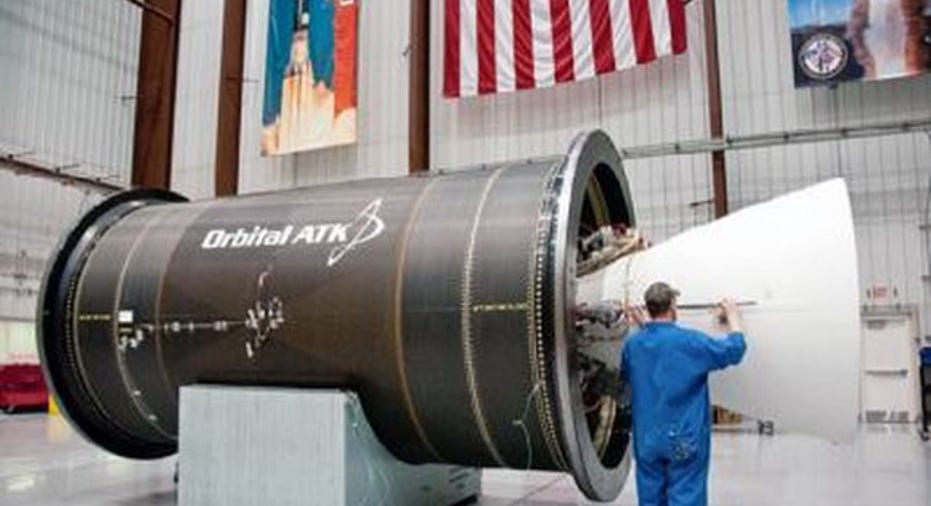Will Orbital ATK Build a New Space Rocket?

Orbital ATK (NYSE: OA) occupies a charmed space in the U.S. market for putting satellites in, er, space.
At one end of the space launch continuum, you have United Launch Alliance, whose Delta IV Heavy launch vehicle, developed by Boeing (NYSE: BA), can put a payload massing in excess of 28 tonsinto orbit in a single launch -- at a cost of $350 million.At the other end, new space start-ups like Vector Space are promising to launch a new generation of small satellites into low-earth orbit for prices as little as $2 million a shot. But what about the middle?
Castor solid rocket engines could provide the "oomph" for a new large rocket from Orbital ATK. Image source: Orbital ATK.
Orbital ATK and the Golden Mean
After all, not all satellites are so massive as to justify spending a third of a billion dollars to get them into orbit. On the other hand, most government and military satellites do mass too much to be carried into orbit aboard a Vector-R small-launch vehicle. Sometimes, the U.S. government just needs a medium-size rocket to carry a medium-size satellite -- and that's where Orbital ATK comes in.
Orbital operates two main rocket families -- Minotaur rockets for payloads ranging from less than a ton to just over three tons, and Antares rockets for payloads up to eight tons -- both targeting the midrange of the rocket market. When a satellite isn't big enough to require a SpaceX Falcon 9 (three times as powerful as Orbital's most robust rocket), Boeing Delta IV, or Lockheed Martin (NYSE: LMT) Atlas V -- but is too big for a Vector-R -- that's when Orbital ATK steps in and offers its services.
So why would Orbital try to change that?
Orbital ATK shoots higher
Right now, Orbital ATK has something close to a lock on medium satellite launches. They're not as lucrative as the big satellite projects (Orbital doesn't publish a price list, as SpaceX and ULA do, but its recent Minotaur launches, for example, have averaged about $26 million per mission). But they're good enough money to provide nearly one-third of Orbital's $4.6 billion in annual revenue -- and at above-average profit margins for the company: 13.7%.
Yet for the past year, Orbital has been working with the U.S. Air Force to develop a large launch vehicle, capable of lifting even bigger payloads to space. Tentatively dubbed the "Next-Generation Launcher"(NGL), this new rocket would use a combination of two solid-fueled lower stages (built in-house by Orbital), assisted with strap-on solid-fueled boosters (likewise)and a modified Blue Origin BE-3U liquid-fueled upper stage, to lift "intermediate and large"payloads to orbit.
Currently, the Air Force is funding two-thirds of the development costs on NGL, with Orbital ATK picking up the final third of the tab. Plans are to green-light the program for further development, or kill it, later this year. If the decision is to proceed, then Orbital CEO Dave Thompson says it will still be several years before the new rocket is ready to launch.
But here's the thing: In Orbital ATK's earnings call earlier this month, Thompson noted that Orbital has observed an "order slump in the [large] commercial satellite market," and expects this "to continue for some time as the major operators rethink their fleet plans, and as they react to downward pressure on transponder prices, and as major additions to their capacity that are in the production pipeline now come online."
Such a trend suggests that even if Orbital gets the go-ahead to develop a new large-payload rocket, there may be little demand among commercial customers to support it. So why build it at all?
Because... government!
Thompson argues that even if commercial demand for large geosynchronous satellite missions is waning, this will be "offset by strength in government satellite demand originating both with NASA and with a number of defense-related customers." It seems that Orbital's strategy going forward, then, is to try to capture some of this government work for itself -- contracts to launch scientific and military satellites that would otherwise be too heavy for Orbital to lift without a new rocket.
In developing a new rocket, Orbital ATK will be leaving its comfort zone and going head to head with rival large rocket builders such as SpaceX, Boeing, and Lockheed, and even (should it be allowed to bid) with Ariane in Europe -- with all the profit margin pressure that will entail.
Orbital ATK shareholders must just cross their fingers and hope the rewards will be worth it.
10 stocks we like better than Orbital ATKWhen investing geniuses David and Tom Gardner have a stock tip, it can pay to listen. After all, the newsletter they have run for over a decade, Motley Fool Stock Advisor, has tripled the market.*
David and Tom just revealed what they believe are the 10 best stocks for investors to buy right now... and Orbital ATK wasn't one of them! That's right -- they think these 10 stocks are even better buys.
Click here to learn about these picks!
*Stock Advisor returns as of February 6, 2017
Rich Smith has no position in any stocks mentioned. The Motley Fool recommends Orbital ATK. The Motley Fool has a disclosure policy.